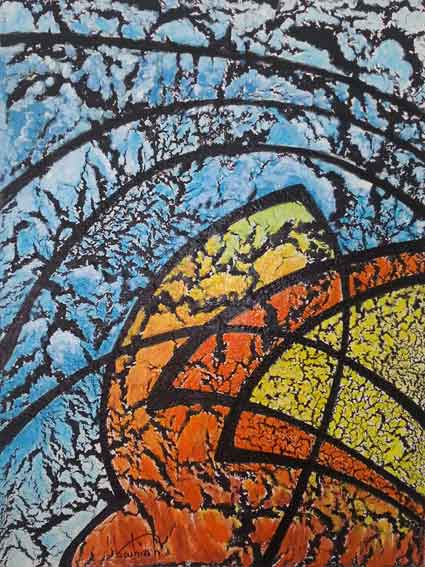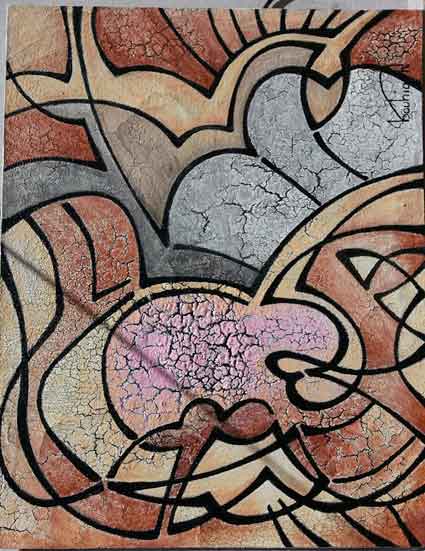Hassan Bouhia
Lines of joy
What meaning may be attributed to language games that seek to bring together the practice of practice of painting (which is an art of space and simultaneity) and that of music (which is an art of time and of ordered succession)? Is this sort of language game only an extended metaphor or does it repose on a basis in truth that would make each art the expression of the same structures and the same sensibilities? In expressions such as “musical painting,” “musical line,” and “colorful tone,”what are we seeking to express? These questions, which all amount to interrogating what Aristotle names “common sense,” and what modern science calls “synesthesia,” can be thought through with the help of Hassan Bouhia’s artwork.
Lines of Joy
"Our era is that of the Great Separation between the real and the abstract and of the blossoming of the later. Yet, perhaps when a new, transformed “realism” will blossom and give forth its fruits – through new procedures and by means of a new perspective that still eludes us – then, perhaps an accord between the abstract and the real will resonate and create a new celestial revelation”
Wassily Kandinsky
Hassan Bouhia, engineer by training and poet at heart, is one of the only living representatives of what painter and essayist Henri Valensi called, at the birth of abstract art, “musicalism.” By musicalism, Valensi did not mean painting that would act as a visual translation of a melody, but, in deeper and more rigorous thinking, to create a term to group together all abstract painting that is neither purely formal nor purely expressive. Closer to the spiritualist research of Kandinsky or Paul Klee than the work of Bernard Venet or Jackson Pollock, musicalist art aims to render the essence of music perceptible rather than illustrating what music is capable of evoking visually. In other words, musicalism is an art that would plunge into the depths of the world in order to evoke - as music does - that which is metaphysical within it, which is to say, in Schopenhauer’s words, its intimate essence1
Yet, what types of artistic procedures allow Hassan Bouhia’s artwork to achieve this type of result? To respond to this question, I will begin by isolating the elements that structure these paintings. Then, I will attempt to bring forth the harmonic logic that underlies the interconnection of these elements. All of Hassan Bouhia’s works repose on the implementation of three elements: the background, which is most often composed of heavy, clear materials that almost always crack; the line, which runs through the savage space of the canvas in visionary directionality; the color, finally, whose function is to create a succession of harmonic chords between the spaces, which would otherwise remain disconnected. Between these three elements, it is the line that has the distinguished privilege of giving each painting its melody. It is through the drawing formed by these lines – or rather, by means of a succession of drawings sometimes forming arabesques that push beyond the space of the canvas (thus creating effects of exteriority), and at other times, quasi-geometric structures that seem to have renounced their ideal forms – that Hassan Bouhia captures the emotional movements that dance within the depths of his being.
All of Hassan Bouhia’s works repose on the implementation of three elements: the background, which is most often composed of heavy, clear materials that almost always crack; the line, which runs through the savage space of the canvas in visionary directionality; the color, finally, whose function is to create a succession of harmonic chords between the spaces, which would otherwise remain disconnected. Between these three elements, it is the line that has the distinguished privilege of giving each painting its melody. It is through the drawing formed by these lines – or rather, by means of a succession of drawings sometimes forming arabesques that push beyond the space of the canvas (thus creating effects of exteriority), and at other times, quasi-geometric structures that seem to have renounced their ideal forms – that Hassan Bouhia captures the emotional movements that dance within the depths of his being.

It is not until these lines form a complete drawing – a drawing that always emerges on top of the living texture of the background4– that the question of color arises (along with that of possible harmonies that a well-thought out use of color can produce between different parts of the background). Like a composer unable to approach technical questions of orchestration until he possesses a melody that can give form to the rest of the piece, it is only after Bouhia creates a strong drawingthat he can begin to ask himself more “technical” questions about his painting. Speaking about his own painting practice, this is how Bouhia describes his process: “The line, the brushstroke is what is important. Through the brushstroke, I feel like I am able to render the hidden parts of myself visible. Everything else – my research around background materials and color harmonies – are a secondary practice.5”
If, in conclusion, I was asked to describe the type of musicality that the artist seeks, I would say that the Hassan Bouhia’s oeuvre – over and against contemporary dissonance (which comprises the most significant portion of contemporary artistic production, both in the visual arts and music) is a work of classical workmanship in the most noble sense of the term. This work does not hold the ambition of destroying the rules of harmony (likedodecaphonicor serial music), but, on the contrary, to use them in an innovative manner (as Debussy did) in order to create a work that is accessible to those contemplating it. Finally, Bouhia’s work – unlike much contemporary art still fascinated with a paradigm of transgression – does not seek to shock his public, but rather to bring them, with infinitely more simplicity and tenderness, luminosity and joy.
Translated by Eric Lynch
1Kandinsky, Wassily.Du spirituel dans l’art.Paris: Edition Gallimard. 2001 (84).
2For further details on the musicalist movement, see Henri ValensiLe musicalisme. For moreinformationon the parallel between the Hassan Bouhia’s artwork and musicalism, see the text by art critic Daniel Couturier entitled, “Hassan Bouhia,Un peintre musicaliste.”
3Schopenhauer, Arthur. The World as Will and Representation.
4With the exception of Bouhia’s daily drawings, which are composed without these textured backgrounds.
5This citation is from an interview that I completed with the artist.
Frédéric-Charles Baitinger
Hassan Bouhia is a marocan artist who is living in Casablanca.
//espacebouhia.com/
